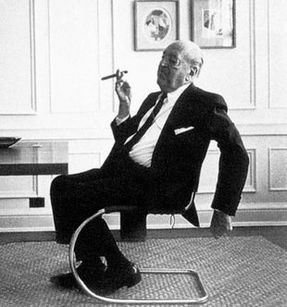Thonet MR 517 Side Table
MR 517 SIDE TABLE
MR 517 SIDE TABLE
The side table MR 517 : the complexity of simplicity
The rediscovery of a versatile classic: on the occasion of the 100 year Bauhaus anniversary, we have re-issued the round side table MR 515 by Ludwig Mies van der Rohe.
The original version is available as a re-edition from the Thonet tubular steel furniture catalogue from 1935 with a tubular steel frame and glass tabletop. This table was presumably created around 1928 in the context of the Esters and Lange Houses in Krefeld designed by Mies van der Rohe.
With a fresh look at the original, Studio Besau Marguerre designed more interpretations of the MR 515, resulting in adaptations that present sensitive embellishments to this furniture classic’s elegance. It combines modern ideas of use and technical details with a contemporary touch.
Marcel Besau’s and Eva Marguerre’s perspective on the table series remains close to the original design, but the details make the difference. Their revisions to the design are both subtle and technical.
The central crossing point of the table legs beneath the glass panel is especially elegant. Based on the research of original versions of the table, the idea of an optional shelf, which adds extra functionality and cosiness to the table series, is also brought back to life.
DESIGNER
MIES VAN DER ROHE
Ludwig Mies van der Rohe, born in 1886 in Aachen, joined Peter Behrens' architectural office at the age of 22; there he met Walter Gropius and Le Corbusier.
Soon, Mies van der Rohe became a protagonist of the new glass and steel architecture of the time. His design for a glass and steel high-rise building at Bahnhof Friedrichstrasse in Berlin was decisive.
He was responsible for the artistic direction of Deutscher Werkbund starting in 1925. In 1927, the Weissenhof Estate in Stuttgart was created under his direction. In 1930, Walter Gropius appointed Mies van der Rohe to the position of director of the Bauhaus; on August 10, 1933 he had to close it under pressure from the NSDAP.
He afterwards emigrated to the United States. In 1938 he went to Chicago, where he took over the direction of the architecture department at the Armour Institute. He became one of the most influential architects in the world.
His steel skeleton buildings with large-scale glass curtain walls such as the Seagram Building in New York (1958) or the National Gallery in Berlin (1968) are among the highlights of modern architecture. His furniture designs usually evolved in connection with his buildings. Ludwig Mies van der Rohe died in 1969 in Chicago.
INFORMATION
SURFACE GROUP
- Tabletop
- Glass
MATERIAL
Tubular Steel Frame And Glass Tabletop
WEIGHT
7.8 kg
FRAME SURFACE
Chrome
TABLETOP SURFACE
Crystal Glass
GLIDERS
Standard (without gliders)
MATERIAL
Tubular Steel Frame And Glass Tabletop
TABLETOP
Clear Safety Glass Tabletop
THONET | TI
4066962020384
DESIGNER
Mies Van Der Rohe
PRODUCT TYPE
Side And Nesting Table
GET INSPIRED
A good piece of furniture lives from its versatility. That is why we rely on functional designs that can be used in a variety of application concepts - see for yourself.







